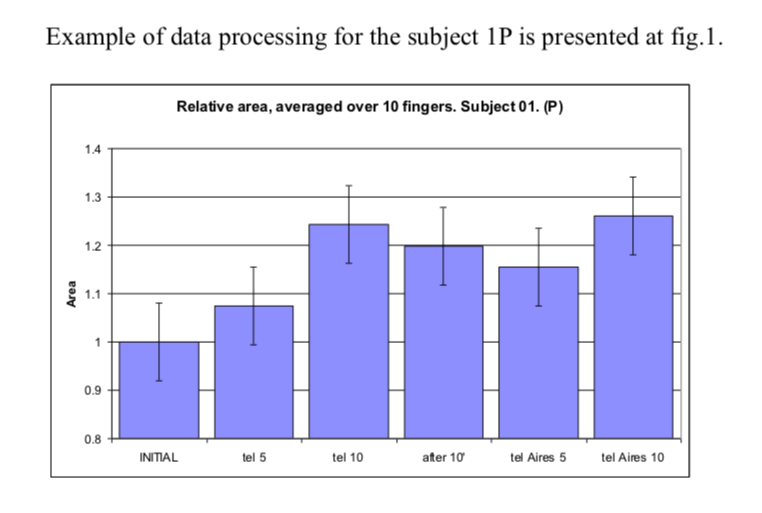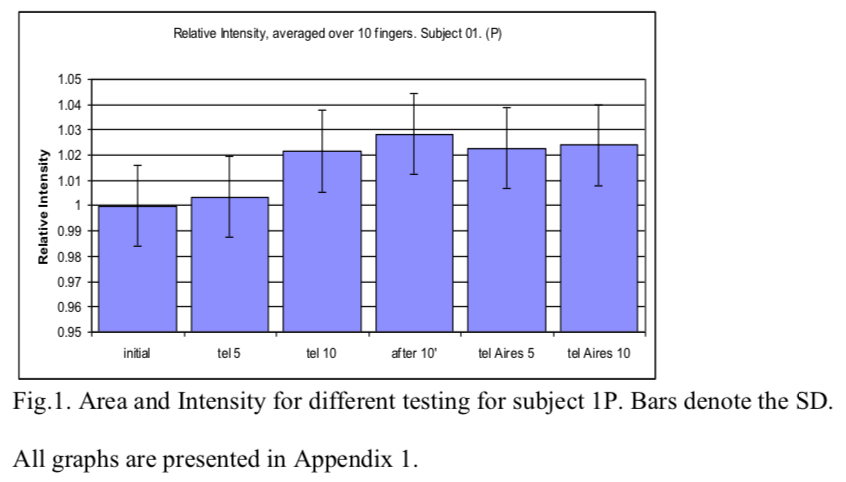RESPONSES OF PEOPLE TO THE MOBILE PHONES AND THE INFLUENCE OF THE PROTECTIVE DEVICES
Korotkov K., Ph.D., Prof., Korotkova A., Ph.D., Petrova E.
Saint Petersburg Research Institute of Physical Culture and Sport
The problem of the influence of mobile phones radiation to human condition attracts more and more attention. In particular, it was demonstrated by electro-acupuncture analysis that functional state of 80% tested people decreased after 1 minute of using mobile phone [1]. In the research work [2] it was demonstrated that mobile phone GSM-900 influenced the bio-electric activity of the brain as detected by electro-encephalogram, while having no influence to cardio-vascular system. The GSM-1800 model produced no measurable effects, and application of a special protector practically diminished the influence.
The aim of this study was the detection of responses of people’s autonomic nervous system to the mobile phones and the influence to this process of the protective devices using Gas Discharge Visualization (GDV) technique.
Methods
The GDV camera is presently the state-of-the-art in bioelectrography [3]. It utilizes a high frequency (1024 Hz), high-voltage (10 kV) input to the finger (or other object to be measured), which is placed on the electrified glass lens of the GDV camera. Because the electrical current applied to the body is very low, most human subjects do not experience any sensation when exposing their fingertip to the camera. In practice, the applied electric field is pulsed on and off every 10 microseconds, and the fingertip is exposed for only 0.5 seconds. This causes a corona discharge of light-emitting plasma to stream outward from the fingertip. The light emitted from the finger is detected directly by a CCD (charge-coupled detector), which is the state-of-the-art in scientific instruments such as telescopes to measure extremely low-level light. The signal from the CCD is sent directly to a computer, and software analysis is done to calculate a variety of parameters that characterize the pattern of light emitted, including brightness, total area, fractality, and density. The software can also provide color enhancement to enable subtle features such as intensity variations of the image to be perceived. The underlying principle of camera operation is similar to the well-known Kirlian effect [4] but modern technology allows reproducible stable data with quantitative computer analysis. Purposeful investigations allowed the discovery of the parameters that are optimal from the point of obtaining critical information on the biological object’s state with the minimum of invasiveness. These findings are described in more than 200 research works in the international scientific literature, 12 patents, 6 books in English, French, German, Italian, Russian, and Spanish.
This biophysical concept of the principles of GDV measurements is based on the ideas of quantum biophysics [5]7. This is a further development of well-known ideas of A. Szent-Györgyi concerning the transfer of electron-excited states along the chains of molecular protein complexes [6]8. The GDV technique measures the level of functional energy stored by the particular systems of an organism. This level is defined by the power of the electron-excited states and the character of their transport along the chains of albumin molecules. The level of functional energy is correlated with health status, but it is only one of many of the components that define health. It works together with genetic predisposition, psycho-emotional states, environmental loading (food, water, air, ecology) and other factors. This approach may be associated with the oriental notion of the energy transfer along meridians.
It was shown in numerous studies that GDV measures the response of the autonomic nervous system to different stimulus.
In assessing human subjects, the GDV-grams (GDV emission patterns after computer processing) of all ten fingers are made and analyzed. All 10 GDV-grams from the fingers then undergo analysis via another software program creating the model of Energy Field around the body and the diagrams showing the energy distribution in the various organ systems. This is based on the map correlating the human fingers with different systems and organs of the body in accordance with Traditional Chinese Medicine (TCM) approach [7].
The technical parameters of the manufactured in Russia “GDV-Camera” (www.korotkov.org) are the following:
- Impulse duration – 10.0 mks;
- Repetition frequency – 11.0 – 3.0 kHz;
- Voltage amplitude – 1000.0 – 4000.0 V;
- Maximum impulse power consumption ~ 80 Watt;
- Schematic impulse current limitation – on the level of 1mA;
- Parameters stability not less than 0.1%;
- Computer control of all the parameters;
- CCD matrix resolution – 800 x 600 .
- In general, the principle of obtaining the information, using the developed approach, can berepresented as follows. Electric impulse stimulates the response of the subject in form of electron and photon emission. Simultaneously, at the expense of superficial and volume heterogeneity of the object, space-time modulation of the applied electromagnetic field (EMF) takes place. Weak emission and photon radiation of the object increases at the expense of the gas discharge, generating in EMF. The glow of this discharge is transformed by the optical and CCD system into a computer file. On the basis of the calculated parameters and diagnostic hypothesis a certain conclusion or diagnosis is made. The picture, formed after processing and transformations, reveals as a two-dimensional amplitude-modulated fractal image. To study this image the methods of fractal, matrix and probability analysis, realised in form of the original program complex on the basis of Windows are used.Experimental Procedure15 practically healthy subjects – volunteers of the age 20-30 years old, all yang women took part in the experiments. The protocol of measurements with the GDV camera of 10 fingers of the subjects was as follows:
- Initial measurements – 3 times with 5 min difference, no phones are turned on in the room. (denote on the graphs as “initial” – data averaged on 3 measurements)
- Mobile phone is turned on in transmission mode and kept nearby the ear of the subject.
- Measurement after 5 minutes with mobile phone on. (tel 5)
- Measurement after 10 minutes with mobile phone on. (tel 10)
- Mobile phone is turned off.
- Measurement after 10 minutes with mobile phone turned off. (after 10)
- “Aires” protector is attached to the phone.
- Mobile phone with “Aires” protector is turned on in transmission mode and keptnearby the ear of the subject.
- Measurement after 5 minutes with mobile phone on. (tel Aires 5)
10. Measurement after 10 minutes with mobile phone on. (tel Aires 10)
As a whole it was 8 measurements for every subject on 10 fingers – 800 images total.
Panasonic EB-G60 and Sony Erickson models were used for the experiment.


Full text:2007 Responses of people to the mobile phones
Image processing was done in the complex of GDV programs.
For every image after noise cleansing two parameters were calculated: Area – the number of exposed pixels of the image after noise processing, and averaged Intensity of the image – in the computer coding range from 0 to 255.
